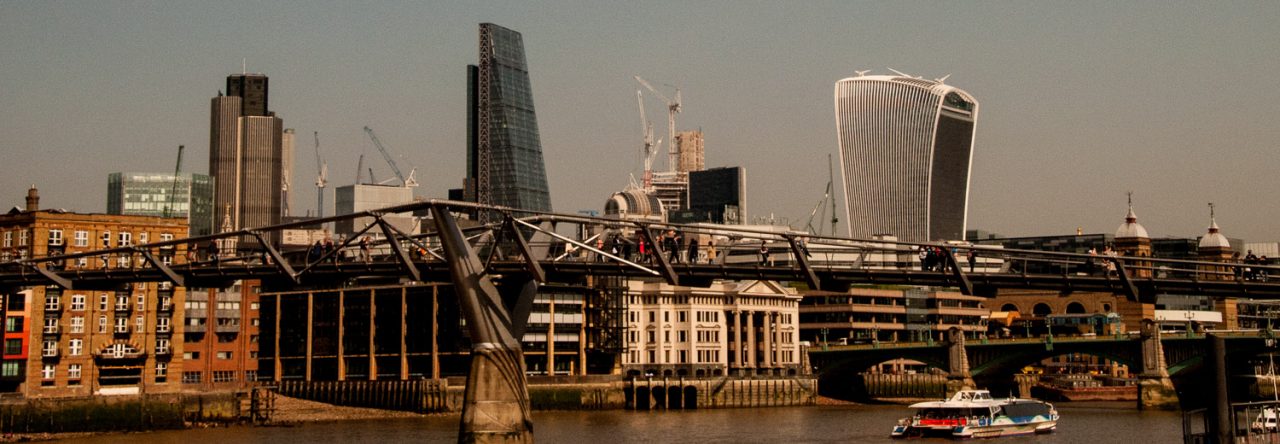Apart from the special Sculpture in the City events, it has been a while since I have specifically sought out other examples of what’s around so last Saturday’s sunny weather proved an ideal opportunity.
I started at Paternoster Square where I had read that the conservation-led artists Gillie and Marc had a new exhibition. Here’s what I found.
Apparently Rabbitwoman and Dogman usually accompany their work and here they hold up an informative panel about the artists …
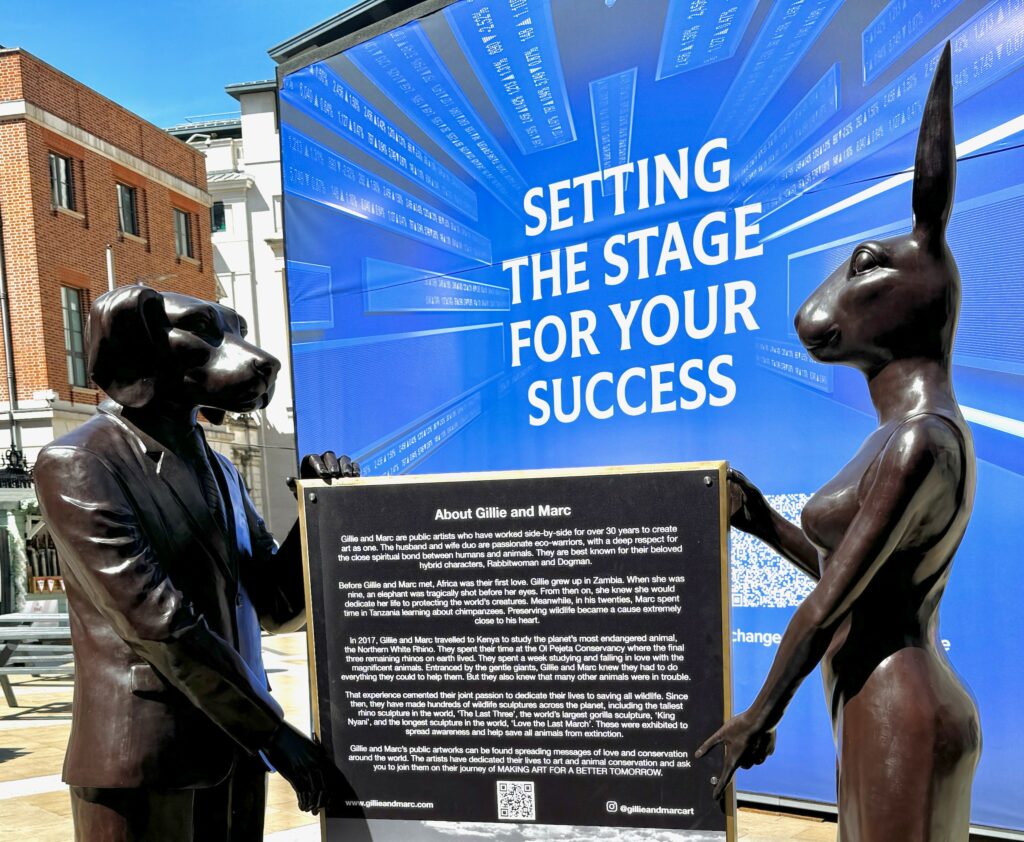
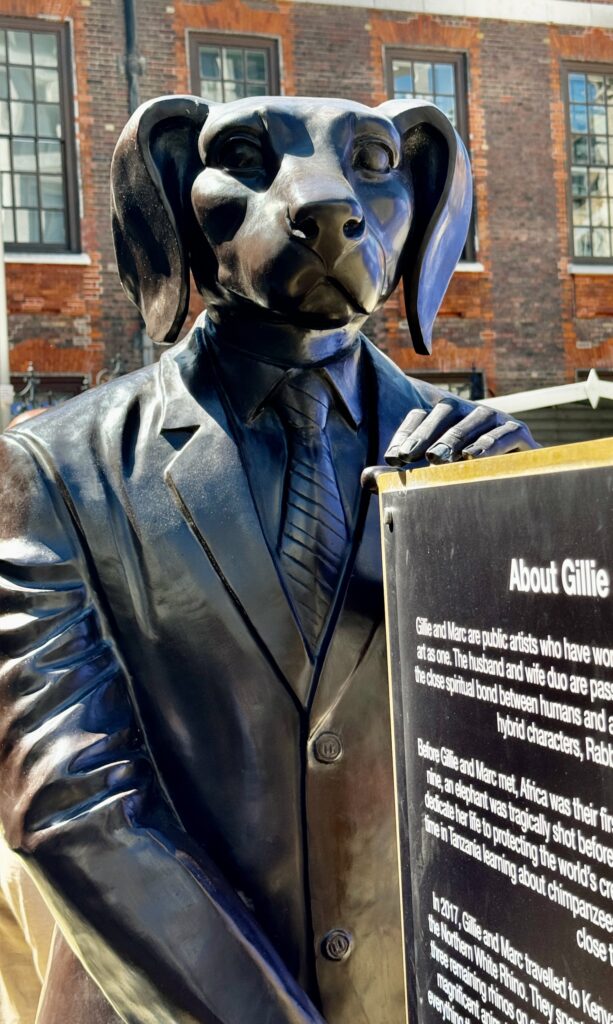
Other animals in the exhibition …
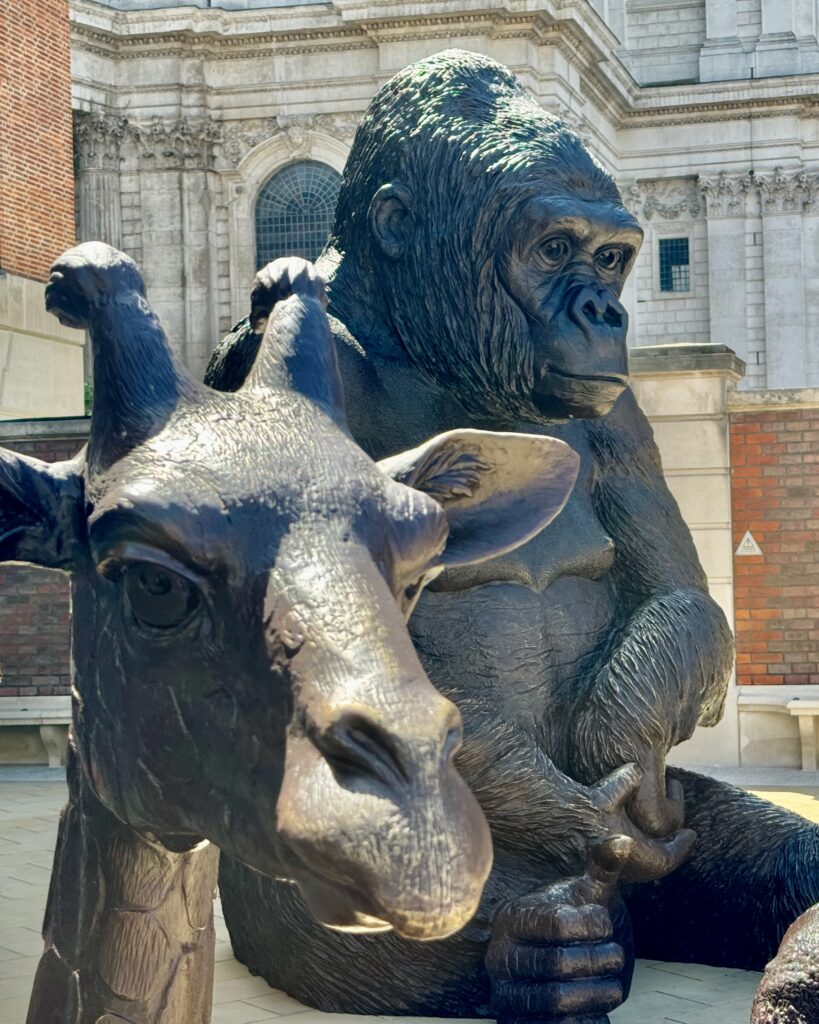
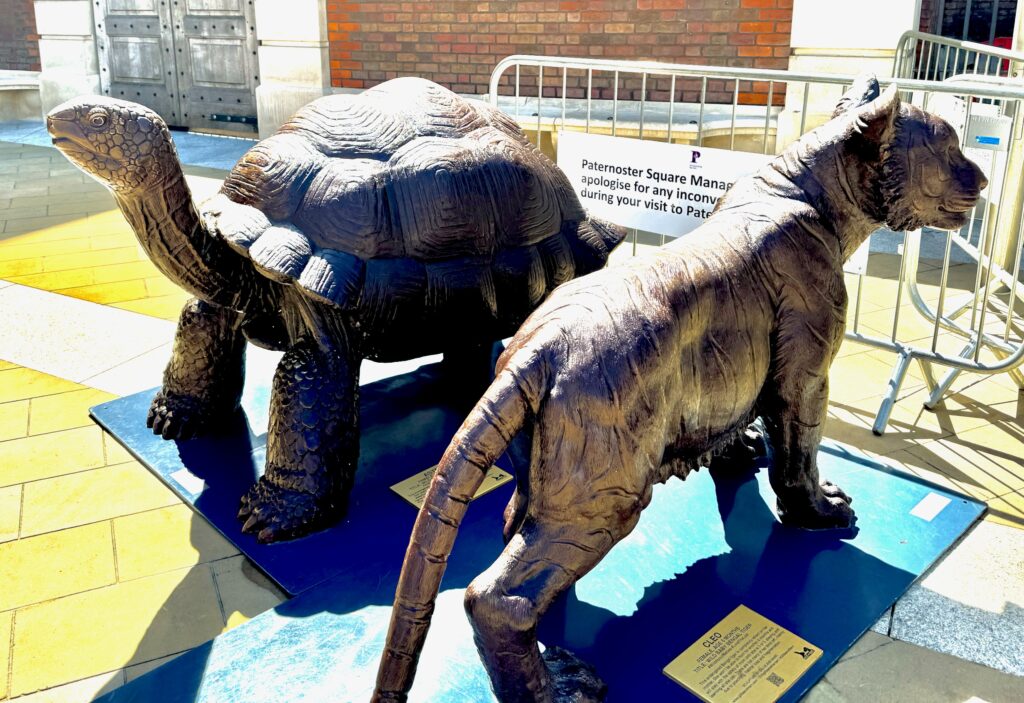
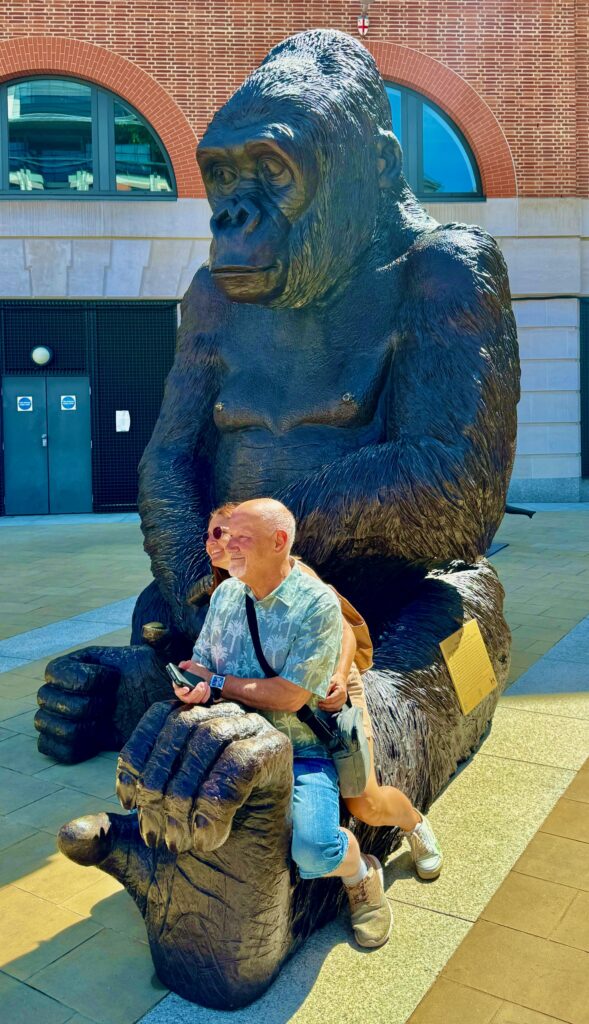
Rabbitwoman and Dogman are known to travel around the City on their scooter. Here they are picking up a coffee at Spitalfields Market …
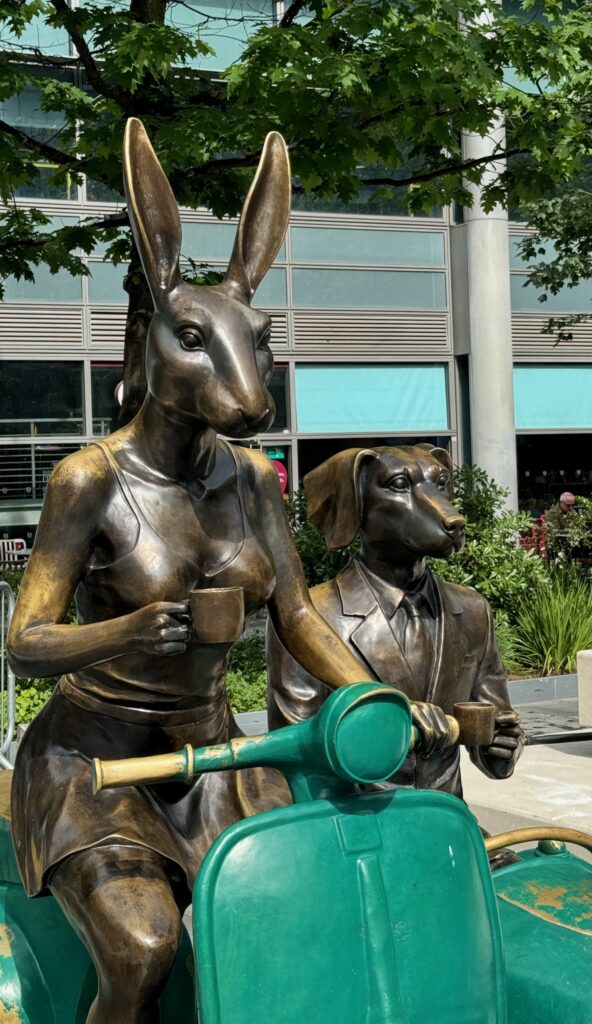
Also in Paternoster Square is a 1975 bronze sculpture by Elisabeth Frink which I particularly like – a ‘naked’ shepherd with a crook in his left hand walks behind a small flock of five sheep …

Dame Elisabeth was, anecdotally, very fond of putting large testicles on her sculptures of both men and animals. In fact, her Catalogue Raisonné informs us that she ‘drew testicles on man and beast better than anyone’ and saw them with ‘a fresh, matter-of-fact delight’. It was reported in 1975, however, that the nude figure had been emasculated ‘to avoid any embarrassment in an ecclesiastical setting’. The sculpture is called, appropriately, Paternoster.
This is The Cordwainer. Here on Watling Street (EC4N 1SR) you are in the Ward of Cordwainer which in medieval times was the centre of shoe-making in the City of London. The finest leather from Cordoba in Spain was used which gave rise to the name of the craftsmen and the Ward. In the background is the wall of St Mary Aldermary church …

Sculpted by Alma Boyes (2002). You can visit her website here.


I love the detail in the work, the craftsman’s face and particularly the hands straining with effort. The statue’s shoes are very beautifully represented too – but then they would have to be.
Easy to miss but worth seeking out is The Building Worker, a bronze statue of a building worker in a pose based on Michelangelo’s David, but in working clothes and wearing a hard hat and carrying a spirit level. He is on Tower Hill EC3 just across the road from the station outside the Tower of London …

The sculptor was Alan Wilson (2006) and it commemorates the ‘thousands of workers who have lost their lives at work … (and) workers who are today building and rebuilding towns and cities across the United Kingdom.’ Wreaths are laid here each year on April 28, International Workers Memorial Day, and a two minute silence is observed at noon in memory of those who have suffered fatal injuries in accidents at work.
The Plumbers’ Hall was compulsorily purchased in 1863 to make way for the expansion of Cannon Street Railway station and this statue on the concourse is a reminder of that connection …
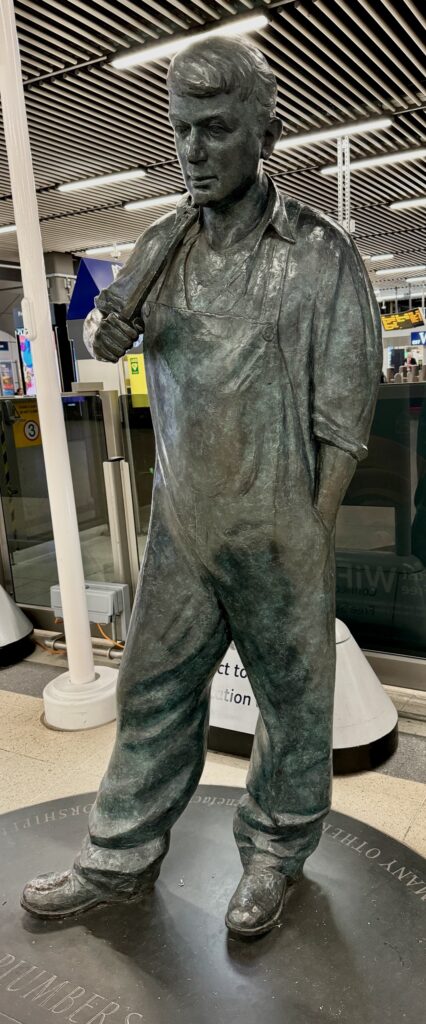
The Plumber’s Apprentice by Mark Jennings (2011).
The inscription reads ‘This statue was erected on the site of its last Livery Hall by The Worshipful Company of Plumbers to celebrate the 400th anniversary of the granting of its Charter by King James I in 1611 and to recognise the support given by the Company to the training of apprentices.’
Now a work that caused a mini-controversy – the Charity Drinking Fountain (also known as La Maternité) by Aimé-Jules Dalou (1877-9).
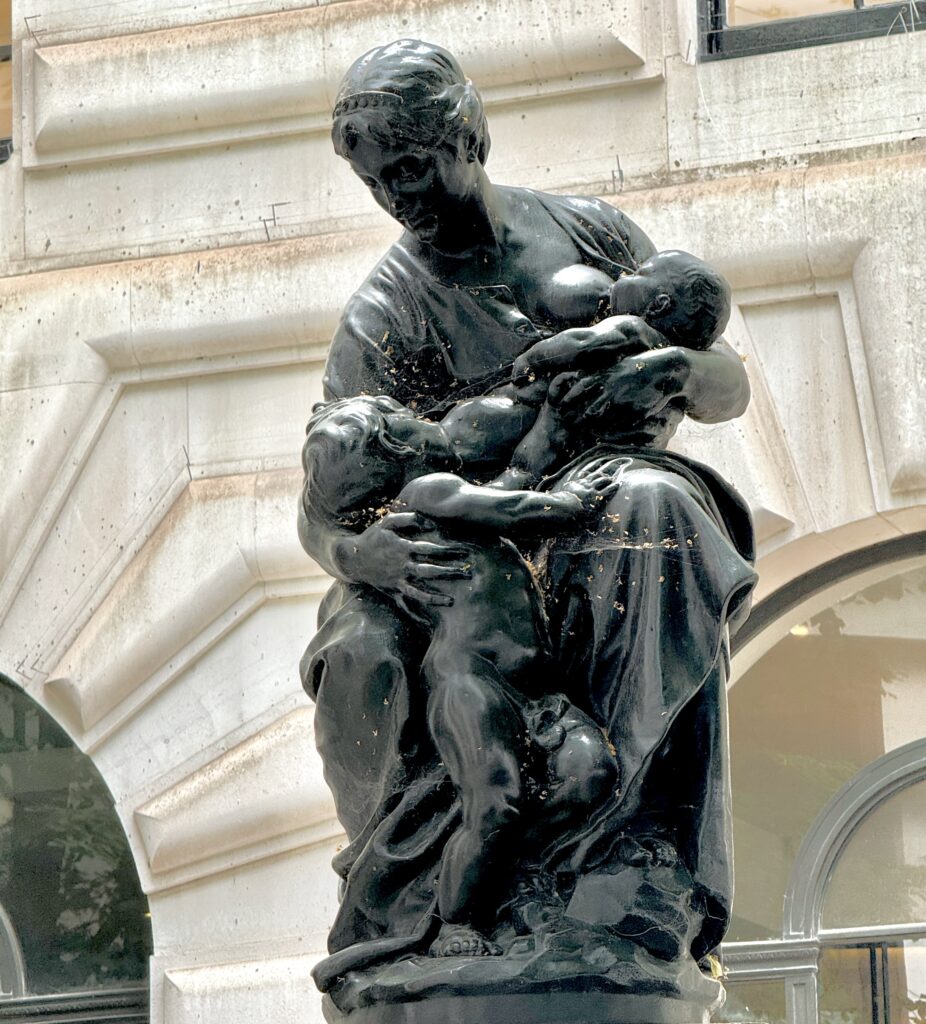
In his book Public Sculpture of the City of London, Philip Ward-Jackson describes the lady as follows:
Despite her casual garb she has a diadem or tiara on her head. With her left arm she enfolds a baby, who she is suckling, whilst with her right she draws to her knee a naked boy, who gazes up at her.
She can be found outside Royal Exchange Buildings, EC3V 3NL.
Nearby is a very relaxed George Peabody who I have written about in an earlier blog …

Ward-Jackson tells us that the suckling lady’s very authentic exposed breast produced at least one letter of protest to the editor of The Globe. The correspondent urged that ‘common decency’ should be observed and went on …
Do you not think, Sir, that Mr Peabody’s chair should be turned, at least until the delicate operation of ‘lacteal sustenation’ be concluded … or the young woman and youngsters provided with the requisite clothing.
If you visit the sculptures today you will, in fact, find that Mr Peabody no longer gazes at the lady who shocked the Globe corresponsent. Surely his letter wasn’t acted upon? I can find no evidence one way or another.
How about this slightly mysterious figure at 193 Fleet Street …

I always thought that it resembled a rather effeminate youth but it is in fact a woman disguised as a pageboy, her name, Kaled, appears just under her right foot.
It is by Giuseppe Grandi, and dates from 1872. The shop owner, George Attenborough, had a niche created specially for it over the front door. Kaled is the page of Count Lara in Bryon’s poetic story of a nobleman who returns to his ancestral lands to restore justice. He antagonises the neighbouring chieftains who attack and kill him. Kaled stays with his master and lover to the end, when it is revealed he is in fact a woman. She goes mad from grief and dies.
Something a little more conventional now, this 1881 statue of Sir Rowland Hill by Edward Onslow Ford, R. A. (1852-1901). It’s on King Edward Street …
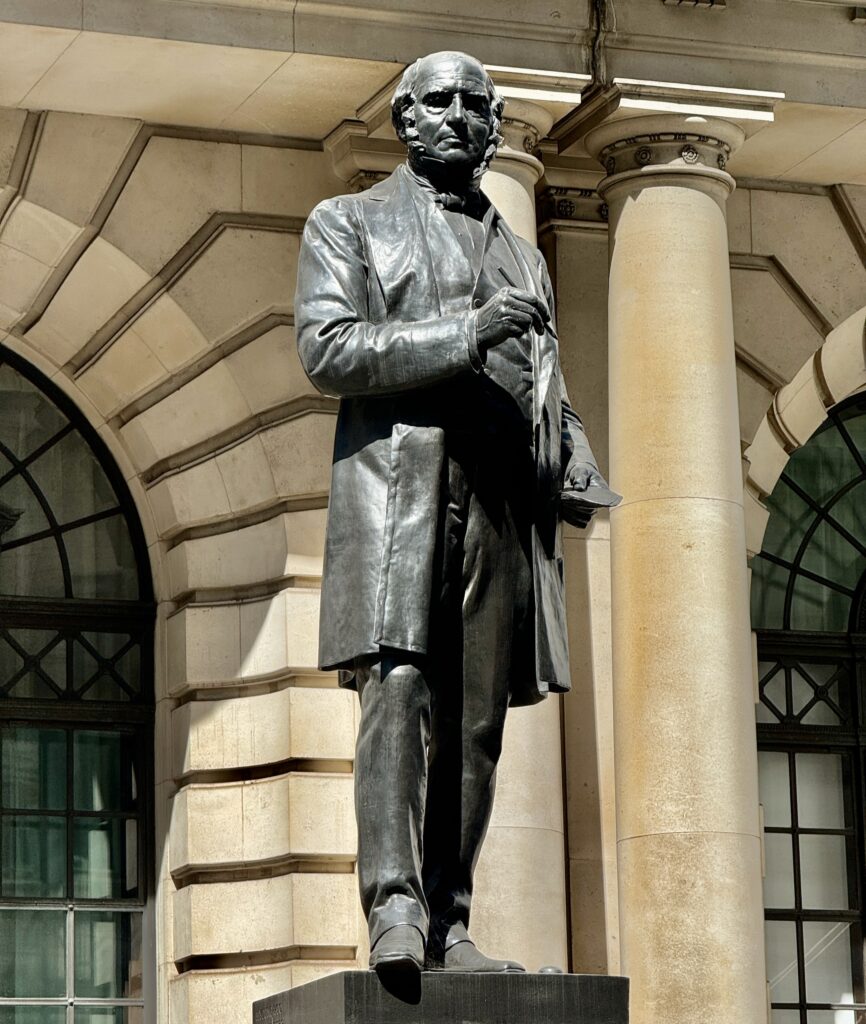
It’s in front of the old General Post Office building. Read more about this fascinating man and his postal reforms here. For example, I didn’t realise that, before 1840, the British postal system was highly complex and very expensive. Letters were charged by distance and the number of sheets of paper they contained. Normally, the charge was paid by the recipient. As a result people often ‘cross-wrote’ their letters to save money. Imagine having to decpher this missive …

I had to include a few examples of Barbican sculpture.
On the Alban Gate highwalk you will encounter two naked writhing dancers. Quite often I have seen people pose for photographs whilst trying to mimic the figures’ movements – they have not found it easy …

The work, called Unity, is by the Croatian Sculptor Ivan Klapez. It was commissioned by the building developers MEPC in 1992 and marked a turning point is his career. I rather like them in silhouette …
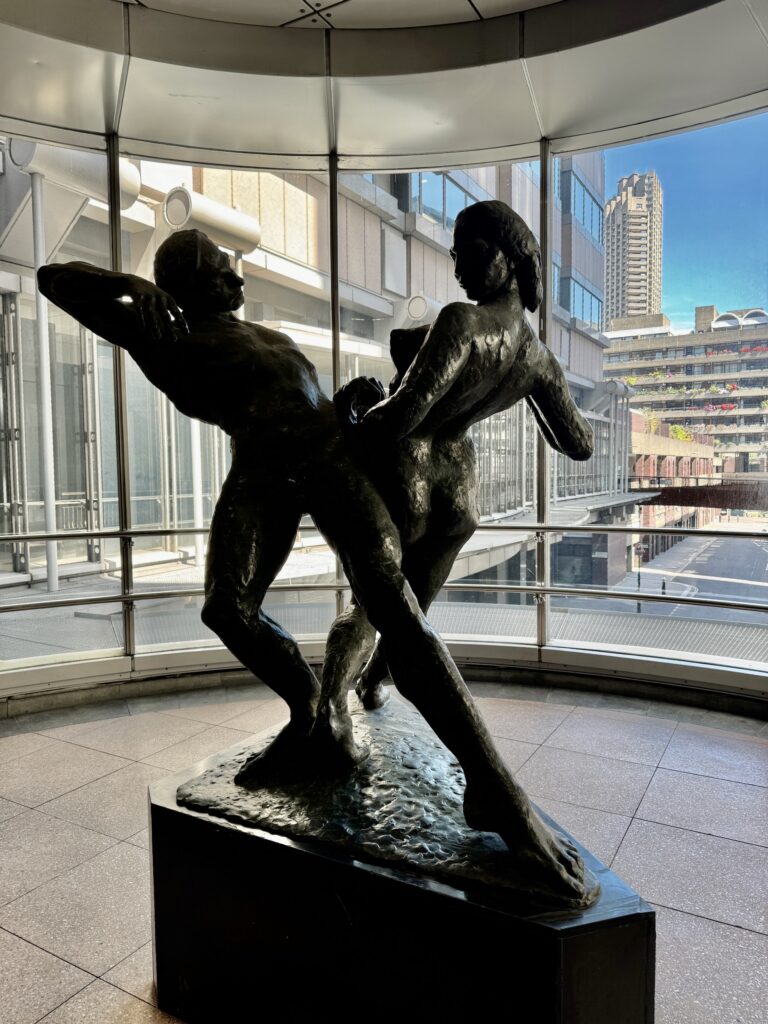
If you visit the sculpture you will see that the male figure is … er … unquestionably male. Shortly after its installation the Daily Telegraph’s ‘City Diary’ recorded local speculation as to whether the penis of the male figure had been shortened ‘to spare the blushes of passing matrons’. The sculptor’s agent insisted that no such concessions had been made. I haven’t included an image of the organ concerned (coward!) so you’ll have to visit and make up your own mind.
The Gladiator, by Eli Ilan (1973) just before you reach the library …
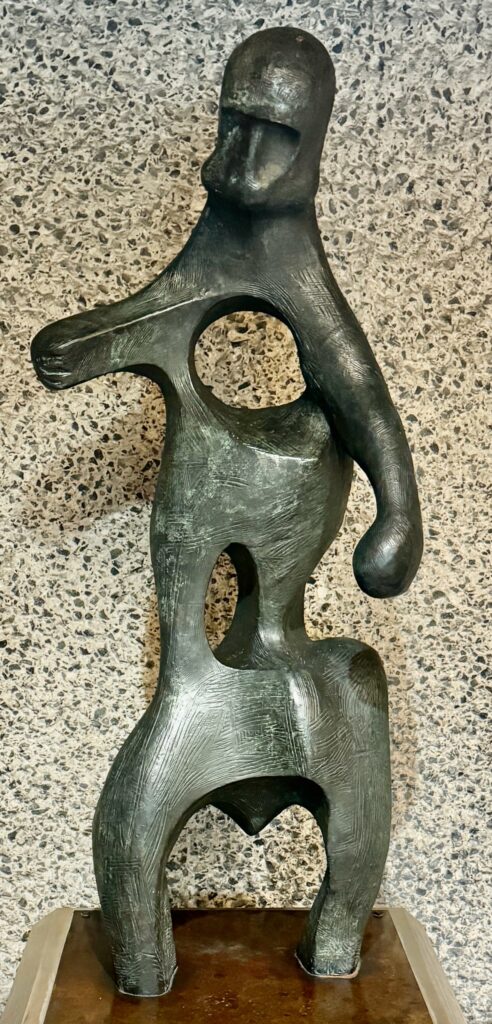
Nice to see that he’s being looked after …
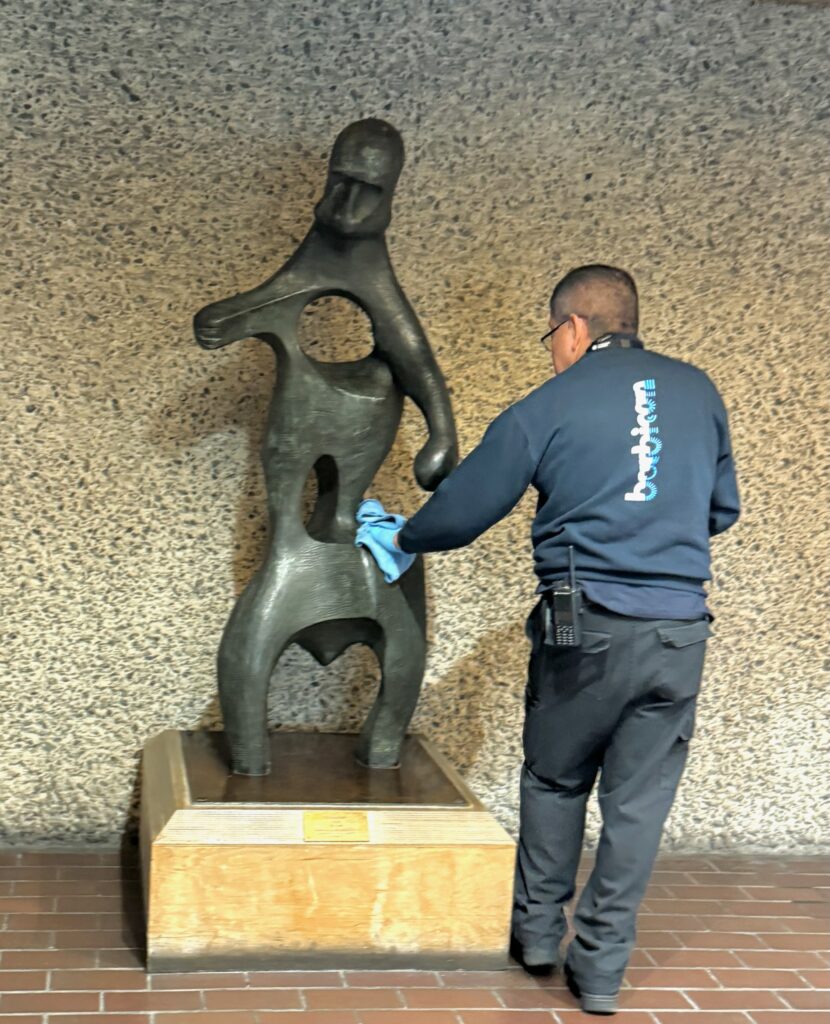
And finally, the magnificent Minotaur by Michael Ayrton. After an itinerant life, he now looks rather wonderful in his more recent location in St Alphage Gardens …
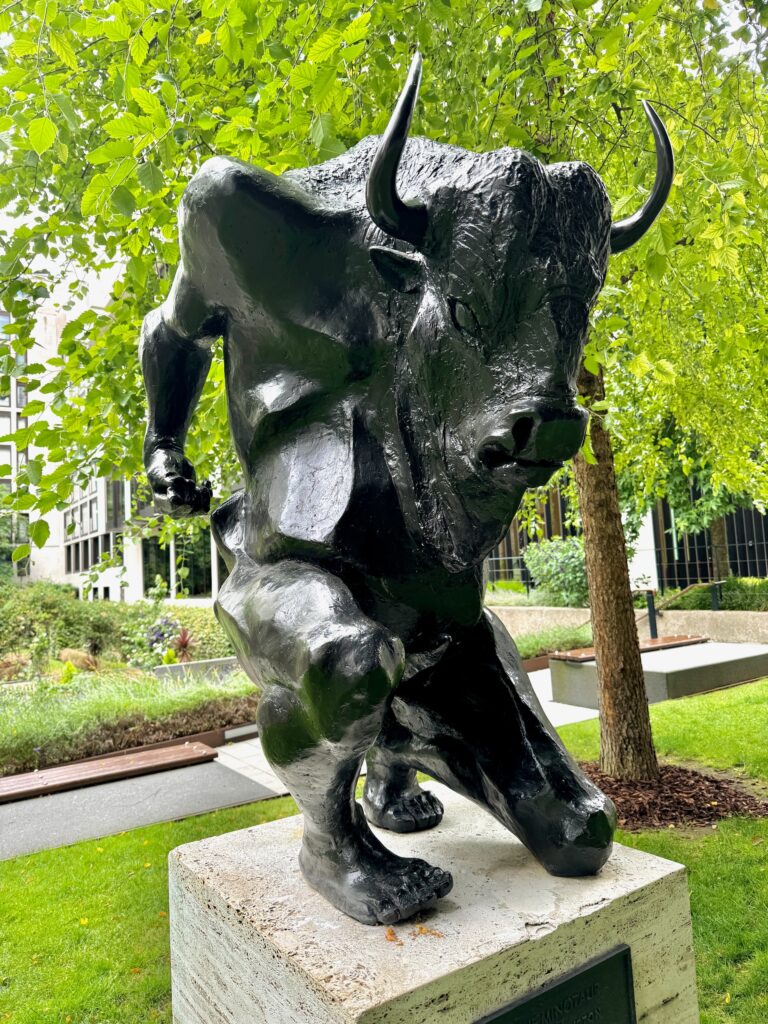
… with a slice of the Roman/Medieval city walls behind him to the left …
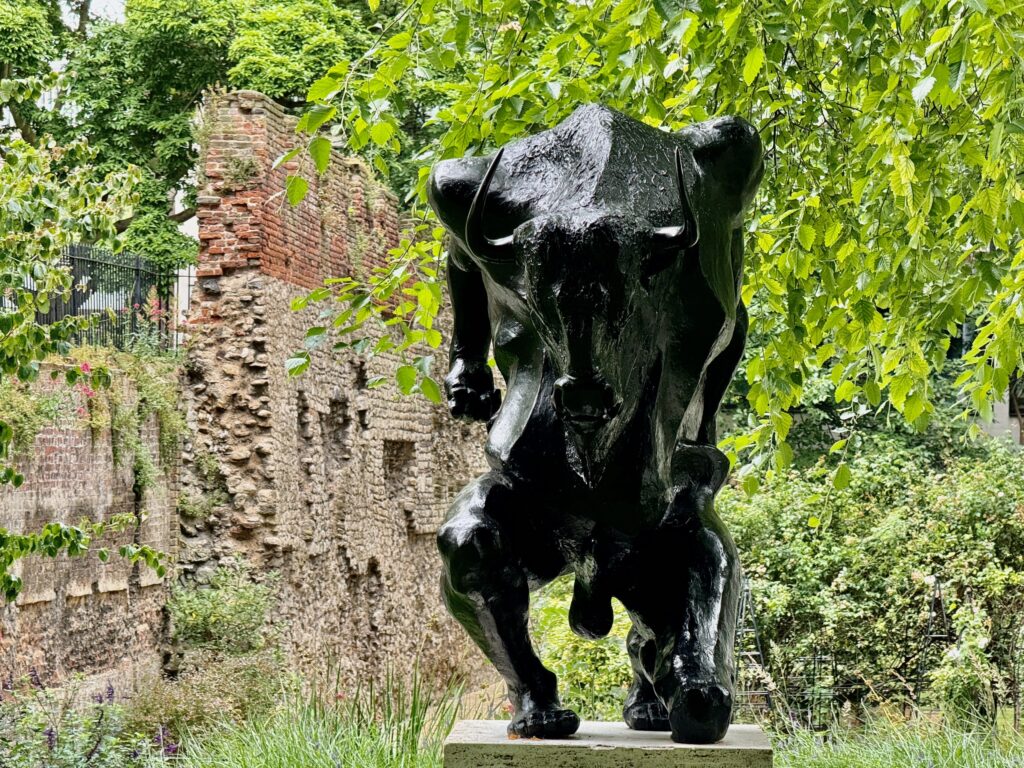
Remember you can follow me on Instagram …
